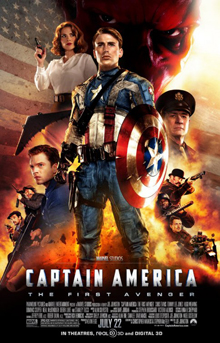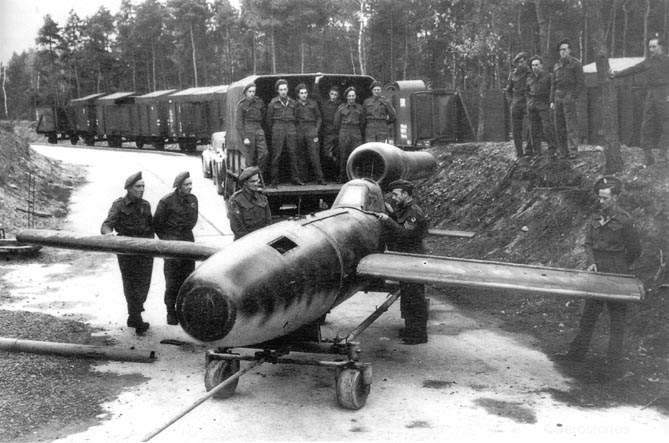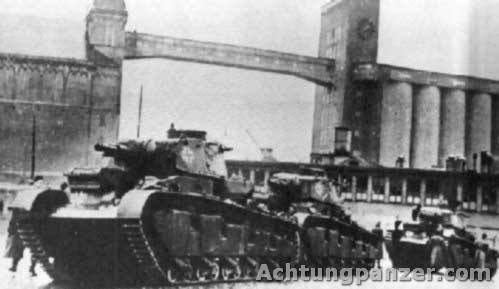Thank you for your condolences, and safe to say JQ and I are coping after the loss. It has been difficult but we have enjoyed mutual support with each other + friends, and we'll honour his memory by carrying on forward. We'll resume putting up posts regularly and once again we thank you for your continued support for this blog!
Unless if you've been living under a rock, you would have heard that Captain America was finally released in cinemas to positive reviews...touching on the U.S. patriotic spirit when the country itself is facing some troubling times. Somewhat akin to Wolfenstein made into a movie, the film had America heroically confronting the mystically crazed Nazis and their disturbing creations.

The poster for the Captain America movie.
To me, the movie was a "typical" Marvel comic book film - featuring a mentor/father figure who sadly dies, a wash-out becoming a superhero through self-realization, the hero winning against the odds stacked against him, a dash of humour here and there, an awkward romance maturing into real love...and cameo appearances by the man Stan Lee himself lol.
Captain America did get the WWII geek in me thinking, on how it tried to contain a fantastic (as in "fantasy-like") story within a historical context. How would the events play out in Captain America that will capture our imagination, and yet avoid contradicting the historical events we know about WWII?
In a Game of Thrones-esque tone, the best of lies are told with a mix of truth.
Nazis are perfect conspiracy theory material, easily depicted as evil/inhumane people bent on world superiority, whose activities are shrouded in mystery that are open to interpretation. As a tale rooted in conspiracy theories, elements in the movie were based on actual events that occurred in WWII...and this really got my geek side dissecting the movie.
Do note, I am not an authority on the historical information and creative processes that the film-makers have used to construct the world of Captain America...but I'll share what I think are some poignant historical parallels to the movie. Most of my info comes from Wikipedia.
The HYDRA Organization

The fearsome Hydra army in Captain America: The First Avenger.
Cap America's main antagonists, the Hydra organization, is somewhat similar to the archaeological societies which researched into the mystical through archaeological research. These societies were indeed founded in Nazi Germany, which included the Ahnenerbe and Amt Rosenberg, and they aimed to present evidence to support the theory that pre-Germanic people had once dominated the earth in the past, thereby validating the existence of the Third Reich. Nazi archaeology was inspired by a Roman text, Germania by Tacitus, which contrasted corrupt Rome against the noble Germanic tribes.


The Ahnenerbe symbol.
In particular, they had searched for evidence that fingerprints of the Nords and Indo-Germans can be found everywhere, from "European-like" architecture of ancient temples to proving the Buddha was indeed an Aryan. Activities included archaeological expeditions (inspiration for Indiana Jones), education of the public on the historicity of German supremacy, and even medical experimentation sponsored by the SS (such as skull measurements to show distinctiveness of Jews as a race, and gruesome tests on how long airmen could survive in freezing water)

A page from Herman Wirth's book, Was Heisst Deutch? Wirth had an interest in runic symbology.
However, unlike the buff and masked super-soldiers of Hydra, the archaeologists/scientists in these societies were mostly amateurs/untrained archaeologists, with a small portion of professionals indeed trained in their field (who also held very extreme views). Funds for archaeological research came from Nazi grants and private donations, but such research was for propaganda purposes and there was no mention of translating such research into god-like weapon technologies.
Captain America featured German spies who operated in the US, and Nazi Germany did plant spies in America using their U-boats. The German Navy made a number of successful U-boat landings in North America and even attacked shipping around Canada, the Gulf of Mexico, and the Caribbean throughout the war. The Germans aimed to plant spies to hold key jobs in the US and transmit strategic information back, and they even attempted to infiltrate the Manhattan project. But more often than not, the spies defected to the CIA which effectively dismantled their spying operations...perhaps evidence of the dwindling morale or poor conditions the spies have experienced in Germany.
U-Boats and North America
Captain America featured German spies who operated in the US, and Nazi Germany did plant spies in America using their U-boats. The German Navy made a number of successful U-boat landings in North America and even attacked shipping around Canada, the Gulf of Mexico, and the Caribbean throughout the war. The Germans aimed to plant spies to hold key jobs in the US and transmit strategic information back, and they even attempted to infiltrate the Manhattan project. But more often than not, the spies defected to the CIA which effectively dismantled their spying operations...perhaps evidence of the dwindling morale or poor conditions the spies have experienced in Germany.
The Amerika Bomber Project
Early in the war, the Luftwaffe mainly dealt with bombing targets within continental Europe, and medium range bombers like the He 111 proved sufficient in their roles. The Germans did start the Amerika Bomber project, which aimed on producing long range bombers to strike at American factories, in hopes of America being distracted with its own defence and leaving Britain exposed to German airpower. But the project was scrapped as it lost precedence to Hitler's "miracle weapons" (like the Me 262 jet fighter), and considerable material shortages due to Allied intervention.

The Ho Vb research aircraft, strangely similar to the one used by the Red Skull.
The B2-like bomber piloted by the Red Skull was nonetheless reminiscent of actual Flying Wing bomber designs by Horten which were put forward as a potential Amerika Bomber. The Flying Wing design ensured the bomber had considerably less drag due to its elimination of the tail and fuselage, while the bomber itself could carry an increased payload and have sufficient range for transatlantic travel. Also, the Horten 229 was the first use of stealth material on an aircraft, as its shape gave a reduced radar signature, and its construction used carbon powder in glue to absorb radar waves.

Blueprint of the Ho 229 flying wing (Arthur Bentely/Flying Wing Films).
Piloted Suicide Bombs
The suicidal bombs in the Red Skull's bomber were also not far from fact. The Luftwaffe had developed the Fi 103R Reichenberg (named where it would be built) piloted bomb, which was technically a V-1 rocket with a man in it. Just before impact, the F-103R pilot had to bail out of the aircraft by removing the cockpit and jumping out. However, the placement of the intake right behind the cockpit ensured that escape was more likely to be fatal (<1% chance!).

The F-103R flying bomb, inspected by British troops (wikipedia).
Alas, the F-103R never saw active deployment, as test pilots died in trying to land it (fitted with skis) after some trial runs...and it was dictated that the German warrior spirit did not involve explicitly suicide missions. But their Japanese allies thought otherwise, and deployed their own Ohka aircraft upon American ships invading Okinawa.
The Multi-turreted Mega Tank
The mega tank deployed by Hydra does have a historical precedent that was actually deployed during WWII. The Neubaufahrzeug ("New Construction Vehicle") was a prototype multi-turreted tank developed during the Inter-war years when tank technology was still at its infancy. The main turret had a 75mm main gun and 37mm coaxial, while 2 more turrets in the front and back were armed with machineguns.

The Neubaufahrzeugs in Oslo, crewed by 6 men and found useless during the war.
For propaganda purposes, the Neubaufahrzeugs were deployed in Norway but failed to make considerable military impact. One got immobilized by British engineers while another was blown up by German engineers after it got stuck in a swamp, and the rest were probably scrapped. The heavy tanks did not fit into the Blitzkrieg tactics of the German army, which favoured maneuverable tanks armed with a single main cannon. None of these giants were ever recorded in having completely levelled a town, unless the town was never to be found :)
That about sums up my historical summary of the movie's creations that may seem quite out of the world...but were actually somewhat true during the actual war. It's my guess that history is always prone to have gaps in its recording, which are always open to creative reinterpretation.
Till next time, take care and peace out!







You guys are good men.
ReplyDeleteNo offense though.. Dint really like the movie that much.Didn't really had the wow appeal as the First Avenger compared to Iron Man.
A really nice insight on the movie and its relation to WW2!
ReplyDeleteCOOL STUFF!!
Well Josh, I must add that it is these GAPS in historical recordings that not only give a creative interpretation but open up to a world of fiction in history that can fascinate our minds.
ReplyDeleteI must say that the WW2 era has spawn many inspirational fantasy stories. In particular, basing it from the Nazi party and the German Army of that time.
ReplyDeleteOne example is the Wolf Brigade.